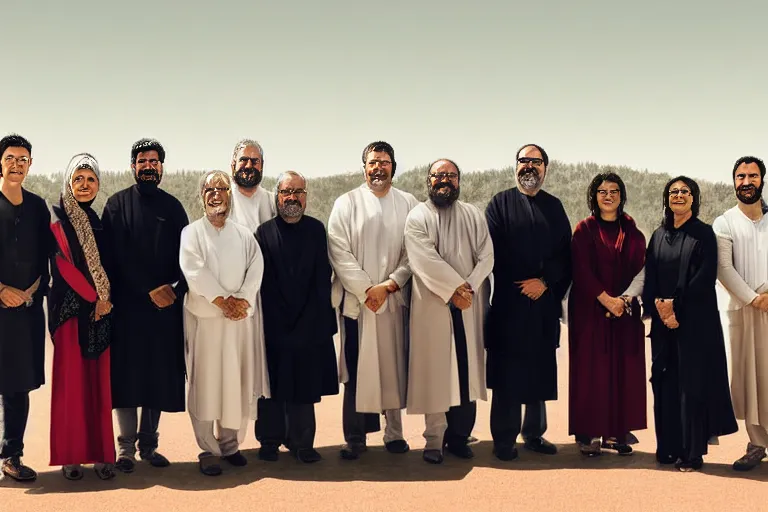Exploring the Complexities and Controversies Surrounding Multireligious Identity
In today’s diverse world, it is not uncommon to encounter individuals who identify with more than one religion. This article delves into the complexities and controversies surrounding multireligious identity, examining various perspectives and beliefs.
The Concept of Multireligious Identity
Can someone really embrace more than one religion? It’s like asking if a river can flow through two different landscapes without losing its identity. Throughout history, many have wondered about this possibility, especially in today’s globalized world where cultures and beliefs intermingle freely.
The concept of multireligious identity is not new; it has roots that trace back centuries. Think of the ancient Greco-Roman pantheon, which was a melting pot of deities from various cultures. Or consider the Jewish community’s acceptance of converts who may have backgrounds in other faiths. Yet, the question still resonates today: Can one genuinely be part of two or more religious communities without compromising their core beliefs?
Some argue that religion is about personal experience and internal truth, making it possible to hold multiple spiritual identities simultaneously. It’s like having a room where you can light candles for different gods; each flame casts its own light but doesn’t extinguish the others.
Others contend that religions are often exclusive by nature, designed as singular paths leading to the same destination. This perspective raises questions about how one can claim allegiance to more than one path without diluting their spiritual essence. It’s akin to trying to wear two different shoes on the same foot—do they both fit comfortably?
Regardless of personal beliefs, the phenomenon of multireligious identity highlights the fluidity and diversity of human spirituality. As we navigate our complex world, the question remains: Are we bound by the strict lines drawn by religious institutions, or can we forge our own paths that embrace the richness of multiple traditions?
Exploring this concept opens up a fascinating dialogue about the nature of belief and how it adapts to the ever-changing tapestry of human experience. Could you be part of more than one religion? The answer might lie in your own heart and spirit, waiting to be discovered.
What path will you choose?
Religious Traditions and Beliefs
When we talk about religious traditions, it’s like stepping into a vast garden filled with diverse flowers, each representing a different faith. Consider Hinduism, for instance—its rich tapestry of gods and goddesses, its profound texts like the Bhagavad Gita, and its emphasis on dharma or duty. Now, let’s contrast it with Islam, which centers around the teachings of the Quran and the life of Prophet Muhammad, offering a strict set of ethical and moral guidelines.
Or think about the spiritual paths of Buddhism, focusing on enlightenment through meditation and the Four Noble Truths. Then there’s Christianity, with its belief in one God and Jesus Christ as the son of God, emphasizing love and forgiveness. And what about Sikhism, which teaches the importance of equality and faith in one creator? Each of these traditions is like a unique color, blending together to create a more vibrant picture.
But can someone truly be part of more than one religion? This question isn’t just theoretical; it’s a lived experience for many individuals. Imagine walking through this garden where each path seems inviting. How do you choose which ones to follow? Some might argue that picking multiple paths is impossible because they believe in the exclusivity of their own faith. However, others see no contradiction and find beauty in the diversity.
Is it not like wearing a multi-colored scarf? Each color stands out on its own but together they create a unique pattern. Similarly, integrating different religious beliefs can lead to a rich spiritual life, enriched by multiple perspectives and practices. Yet, this journey is fraught with challenges. How do you balance the sometimes conflicting teachings of various religions?
The answer lies in personal choice and open-mindedness. Just as blending colors requires care and attention, merging faiths demands respect and dialogue. It’s about finding a harmonious blend that resonates deeply within an individual’s soul.
The Controversies Surrounding Multireligious Identity
Can someone truly embrace multiple religions, weaving their beliefs and practices into a cohesive tapestry of faith? This question has sparked heated debates and complex identities among individuals who find themselves drawn to more than one spiritual path. Is it like trying to fit a square peg in a round hole, or is there room for overlap and integration?
The concept of multireligious identity often faces cultural objections, with communities sometimes viewing such practices as a betrayal or dilution of their core beliefs. How can someone navigate the expectations of one religious community while respecting another? It’s like being torn between two worlds—each offering its own unique flavor but leaving you feeling incomplete.
Socially, multireligious individuals might face challenges in their personal and professional lives. They may encounter skepticism or even hostility from those who believe that religion is all-or-nothing. How do they balance the need to belong with the desire to explore multiple spiritual paths? It’s like walking a tightrope, where every step can either lead you closer to your goal or push you off balance.
Religiously, the question of whether one can be part of more than one religion touches on fundamental beliefs about the nature of truth and faith. Some argue that true devotion requires an exclusive commitment, while others see value in exploring different spiritual traditions. How do these conflicting views impact multireligious individuals? It’s like trying to find common ground between two vastly different maps—each offering a unique perspective but both claiming absolute accuracy.
The controversies surrounding multireligious identity challenge us to rethink our understanding of faith and belonging. Can we accept that people can have complex, multifaceted spiritual lives? Or must religion remain a rigid, singular framework?
Case Studies of Multireligious Individuals
Imagine stepping into the shoes of individuals who navigate the intricate web of multiple religious identities. How do they reconcile their beliefs and practices? Let’s dive into some real-life examples that highlight these unique spiritual journeys.
‘How does one manage to find solace in both Hinduism and Christianity?’ asks Priya, a multireligious individual who grew up in India but now lives in the United States. She describes her experience as a blend of cultures, where each religion offers different perspectives on life and faith.
Priya’s story is just one example. Meet Raj, another individual who identifies with both Islam and Sufism. He explains that his spiritual path involves finding common ground in the teachings of the Prophet Muhammad and the mystical elements of Sufism. ‘Isn’t seeking truth a universal pursuit?’ he wonders, emphasizing how different religious paths can lead to similar goals.
- Case Study 1: Priya’s journey intertwines cultural traditions with personal beliefs, reflecting her bicultural identity.
- Case Study 2: Raj finds harmony between Islam and Sufism by focusing on shared spiritual values like compassion and peace.
These stories illustrate that multireligious individuals often seek commonalities rather than contradictions. They blend their beliefs, creating a rich tapestry of faith that enriches their lives in profound ways. Can such an approach lead to greater understanding and tolerance among different religious communities?
The Role of Education and Dialogue in Understanding Multireligious Identity
How can someone be part of more than one religion, you might wonder? It’s a question that has puzzled many and sparked intense debates about identity, tradition, and belief. The idea itself seems almost paradoxical—like trying to fit two pieces into the same puzzle hole. But for some individuals, embracing multireligious identity is not just possible; it’s a rich tapestry of spiritual experiences woven together.
Education plays a crucial role in understanding and accepting these diverse identities. Through schools and universities, we can learn about different faiths and their practices, fostering an environment where open-mindedness prevails. Imagine if each religion was like a different hue in a palette—education helps us recognize the beauty in every shade, even when they overlap or blend together.
Dialogue is another vital component. Engaging in conversations with individuals from various religious backgrounds can shed light on their perspectives and challenges. These dialogues are not just about exchanging information but also about sharing personal experiences and commonalities that transcend religious boundaries. It’s like sitting around a campfire, where everyone brings their stories and learns something new.
Open-mindedness is the key that unlocks these complex identities. We must be willing to listen, understand, and respect each other’s beliefs without judgment. Just as a river flows through different landscapes, carrying its water with it, so too can we carry our religious heritage and learn from others along the way.
By promoting education, dialogue, and open-mindedness, we can foster a more inclusive society where multireligious identities are not only accepted but celebrated. After all, isn’t life itself a journey of continuous learning and growth? And in embracing diversity, we enrich our own spiritual landscapes, making the world a richer place for everyone.
Conclusion: Embracing Diversity and Promoting Mutual Understanding
As we conclude our exploration into multireligious identity, it becomes clear that embracing diversity and promoting mutual understanding are not just ideals but essential practices in today’s interconnected world. How can someone be part of more than one religion? The answer lies in recognizing the fluidity and richness of human spirituality.
Is it possible to honor multiple traditions without diluting their essence?
This question invites us to think about the depth and breadth of spiritual journeys. Just as a river can flow through diverse landscapes, carrying different influences yet maintaining its core identity, individuals too can traverse various religious paths while preserving their unique beliefs.
Firstly, embracing diversity means acknowledging that multiple religious affiliations are not mutually exclusive but can coexist harmoniously. This is seen in many historical and contemporary examples where people integrate elements from different faiths into their personal practices.
Secondly, promoting mutual understanding requires an open-hearted approach to dialogue. It’s about listening with empathy and learning without judgment. How can we bridge the gaps between religious communities if we remain entrenched in our beliefs?
Respecting individual spiritual journeys is paramount. Each person’s path is as unique as their fingerprint, shaped by personal experiences, cultural backgrounds, and inner convictions. We must respect these differences and celebrate them, fostering an environment where diversity thrives.
Can we imagine a world where religions are not seen as barriers but as bridges connecting hearts?
The journey of multireligious identity is a testament to the complexity and beauty of human spirituality. As we move forward, let us strive to create spaces where people can explore their faiths freely, connect with others across religious divides, and contribute to building a more inclusive and compassionate society.
Conclusion
 Ultimately, the question of whether someone can be part of more than one religion is a deeply personal one that requires careful consideration and understanding. It is essential to respect and appreciate the unique spiritual journeys of others while fostering open dialogue and mutual understanding.
Ultimately, the question of whether someone can be part of more than one religion is a deeply personal one that requires careful consideration and understanding. It is essential to respect and appreciate the unique spiritual journeys of others while fostering open dialogue and mutual understanding.











